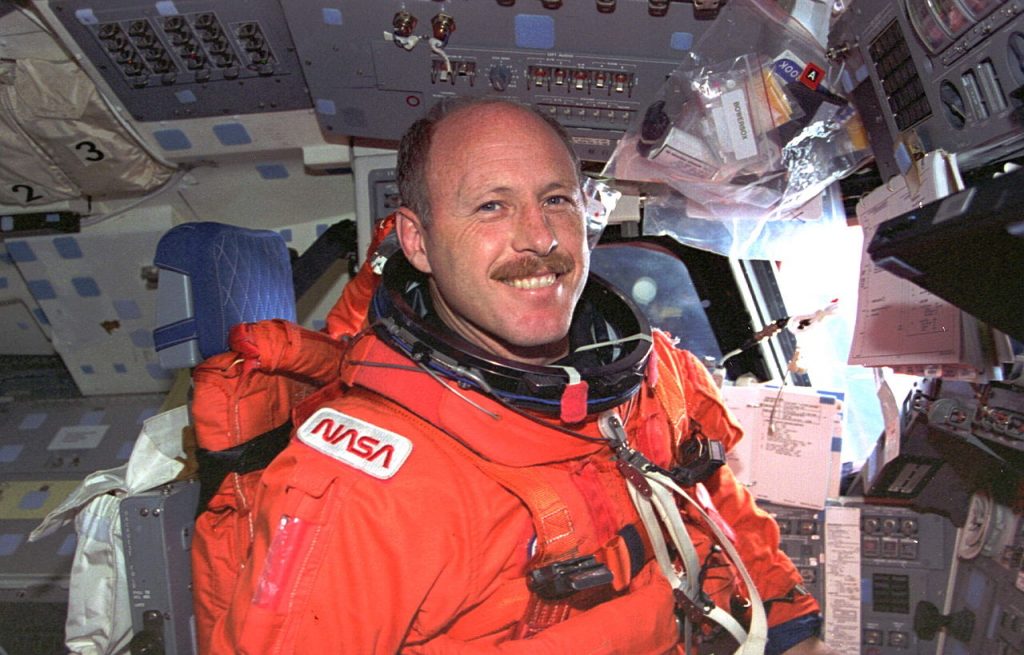
Ken Bowersox (19th Co.) was Aeronautical Engineering major at the Naval Academy. He played 150 lb football and was on the sailing team participating in races out of Newport, Rhode Island, finishing 3rd in the Newport to Bermuda MHS class, a handful of races out of Marblehead, Massachusetts, and in Edgartown Race Week. Ken was accepted to the Academy Exchange Program and went to US Air Force Academy first semester Second Class Year where he earned his gold jump wings. During First Class Year, Ken applied for and was accepted into the Immediate Graduate Education Program earning a Masters Degree in Mechanical Engineering at Columbia University.
Following his time at Columbia, Ken attended flight school and after being designated a Naval Aviator was assigned to Attack Squadron 22, aboard the USS Enterprise, where he served as a Fleet A-7E pilot, logging over 300 carrier arrested landings. Following that tour he attended and graduated from the United States Air Force Test Pilot School at Edwards Air Force Base, California. In 1985, he moved to the Naval Weapon Center at China Lake, California, where he spent the next year and a half as a test pilot flying A-7E and F/A-18 aircraft until advised of his selection to the astronaut program. He has logged over 4,000 hours flight time.
Selected as an astronaut candidate by NASA in June 1987, Ken completed a one-year training and evaluation program in August 1988. He held a variety of assignments since then including: flight software testing in the Shuttle Avionics Integration Laboratory (SAIL); Technical Assistant to the Director of Flight Crew Operations; Astronaut Office representative for Orbiter landing and rollout issues; Chief of the Astronaut Office Safety Branch; Chairman of the Spaceflight
Safety Panel; during several Shuttle missions he served as a spacecraft communicator (CAPCOM) in the Houston Mission Control Center; was back-up to the first International Space Station crew; and served as the Director, Flight Crew Operations Directorate. A five flight veteran, Ken logged over 211 days in space including 2 Extravehicular activities (spacewalks) totaling 13 hours and 17 minutes. He was the pilot on STS-50 (1992) and STS-61 (1993), spacecraft commander on STS-73 (1995) and STS-82 (1997), and most recently served as Expedition-6 Crew Commander for 5-1/2 months aboard the International Space Station (2002-2003). Ken retired from NASA and the U.S. Navy in December 2006.
Ken served as the director of the Johnson Space Center’s Flight Crew Operations Directorate, retiring from NASA and the U.S. Navy in December, 2006. He remained involved with the U.S. space exploration program as a member of the standing review boards for ISS, Space Shuttle, and the Constellation Program. From 2009-2011, Ken was the Vice President of Astronaut Safety and Mission Assurance at SpaceX. He joined the NASA Advisory Council in November 2013, and served as Chair of the Human Exploration and Operations Committee. Bowersox then served as the Interim Chair of the NASA Advisory Council from June 2016 to January 2017. On July 10, 2019, he was named acting associate administrator for NASA’s Human Exploration and Operations Mission Directorate.
Ken and his wife Ann have three sons, Matthew, John and Luke.
Ken appears on the US Naval Academy Website under USN / Notable Graduates / Astronauts / Ken Bowersox
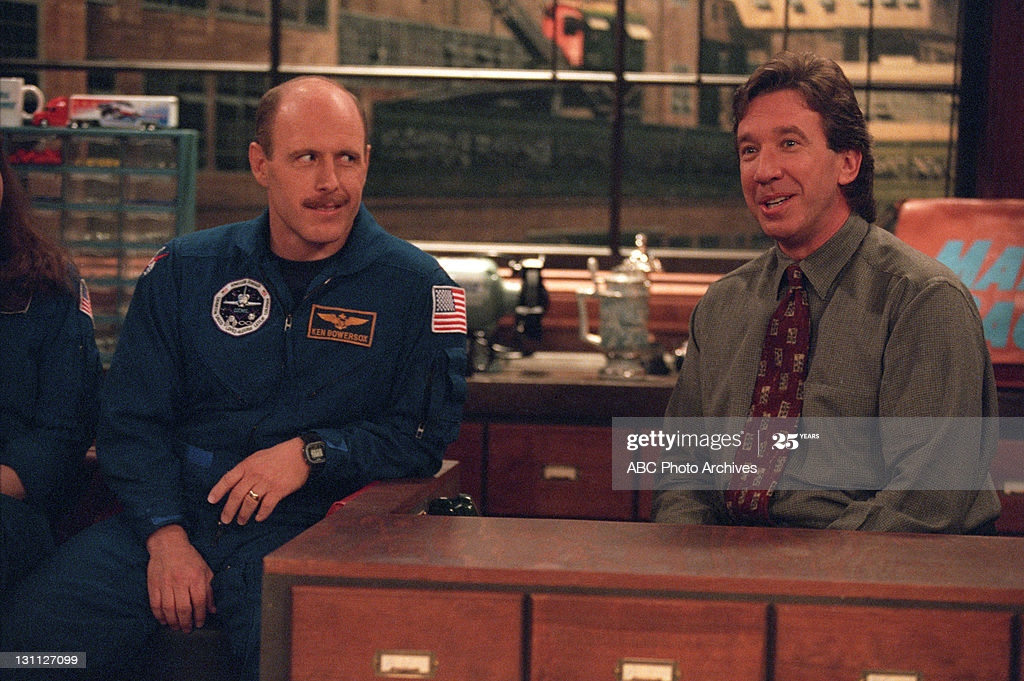
Ken on Home Improvement , February 13, 1996
SPACE FLIGHT EXPERIENCE
STS-50
STS-50, June 25-July 9, 1992, was a United States Space Shuttle mission, the 12th mission of the Columbia orbiter. Columbia landed at Kennedy Space Center for the first time ever due to bad weather at Edwards caused by the remnants of Hurricane Darby The U.S. Microgravity Laboratory 1 was a spacelab mission, with experiments in material science, fluid physics and biotechnology. It was the first flight of a Space Shuttle with the Extended Duration Orbiter (EDO) hardware, allowing longer flight durations.

The STS-50 crew portrait includes (from left to right): Ellen S. Baker, mission specialist; Kenneth D. Bowersox, pilot; Bonnie J. Dunbar, payload commander; Richard N. Richards, commander; Carl J. Meade, mission specialist; Eugene H. Trinh, payload specialist; and Lawrence J. DeLucas, payload specialist.
STS-61
STS-61, Dec. 2-13, 1993, was the first Hubble Space Telescope servicing mission, and the fifth flight of the Space Shuttle Endeavour. The mission launched from Kennedy Space Center in Florida. The mission restored the spaceborne observatory’s vision (marred by spherical aberration in its mirror, with the installation of a new main camera and a corrective optics package. This correction occurred more than three and a half years after the Hubble was launched aboard STS-31 in April 1990. The flight also brought instrument upgrades and new solar arrays to the telescope.
With its very heavy workload, the STS-61 mission was one of the most complex in the Shuttle’s history. It lasted almost 11 days, and crew members made five spacewalks (Extravehicular Activities, or EVAs), an all-time record; even the re-positioning of Intelsat VI on STS-49 in May 1992 required only four. The flight plan allowed for two additional EVAs, which could have raised the total number to seven; the final two contingency EVAs were not made. In order to complete the mission without too much fatigue, the five EVAs were shared between two pairs of different astronauts alternating their shifts.

Astronauts included in the STS-61 crew portrait include (standing in rear left to right) Richard O. Covey, commander; and mission specialists Jeffrey A. Hoffman, and Thomas D. Akers. Seated left to right are Kenneth D. Bowersox, pilot; Kathryn C. Thornton, mission specialist; F. Story Musgrave, payload commander; and Claude Nicollier, mission specialist.
STS-73
STS-73, Oct. 20 to Nov. 5, 1995, was a Space Shuttle program mission, during October–November 1995, on board the Space Shuttle Columbia. The mission was the second mission for the United States Microgravity Laboratory. The crew, who spent 16 days in space, were broken up into 2 teams, the red team and the blue team. The mission also included several Detailed Test Objectives.
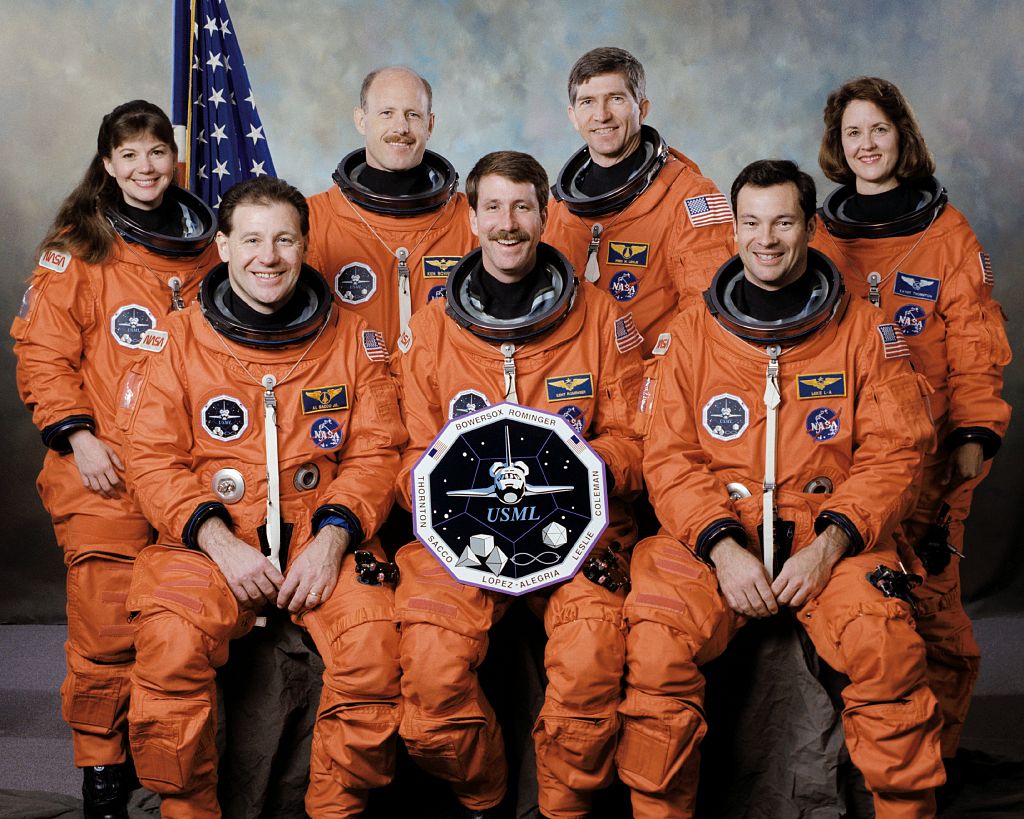
Crew of the Space Shuttle mission STS-73. NASA photo STS073-S-002 taken July 1995. :On the front row, left to right, are Albert Sacco Jr., payload specialist; Kent V. Rominger, pilot; Michael E. Lopez-Alegria, mission specialist. On the back row are, left to right, Catherine G. Coleman, mission specialist; Kenneth D. Bowersox, commander; Fred W. Leslie, payload specialist; and Kathryn C. Thornton, payload commander.
STS-82
STS-82, Feb. 11-21, 1997, was the 22nd flight of the Space Shuttle Discovery and the 82nd mission of the Space Shuttle program. It was NASA’s second mission to service the Hubble Space Telescope, during which Discovery’s crew repaired and upgraded the telescope’s scientific instruments, increasing its research capabilities and achieved the highest altitude ever attained by a STS Orbiter (335-nautical-mile (620 km)). Work performed by Discovery’s crew significantly upgraded the scientific capabilities of the HST and helped to keep the telescope functioning smoothly until the next scheduled servicing missions, which were STS-103 in 1999 and STS-109 in 2002. In addition to installing the new instruments, astronauts replaced other existing hardware with upgrades and spares. Hubble received a refurbished Fine Guidance Sensor, an optical device used to provide pointing information for the telescope and as a scientific instrument for astrometric science. The Solid State Recorder (SSR) replaced one of HST’s reel-to-reel tape recorders. The SSR provides much more flexibility than a reel-to-reel recorder and can store ten times more data. One of Hubble’s four Reaction Wheel Assemblies (RWA) — part of the telescope’s Pointing Control Subsystem—was replaced with a refurbished spare.[3] The RWAs use angular momentum to move and maintain the telescope in a desired position. The wheel axes are oriented so that the telescope can provide science with only three wheels operating, if required.[1] Study of the returned mechanism provided a rare opportunity to study equipment that had undergone long-term service (7 years) in space, particularly for the effects of vacuum on lubricants which were found to be in ‘excellent condition’
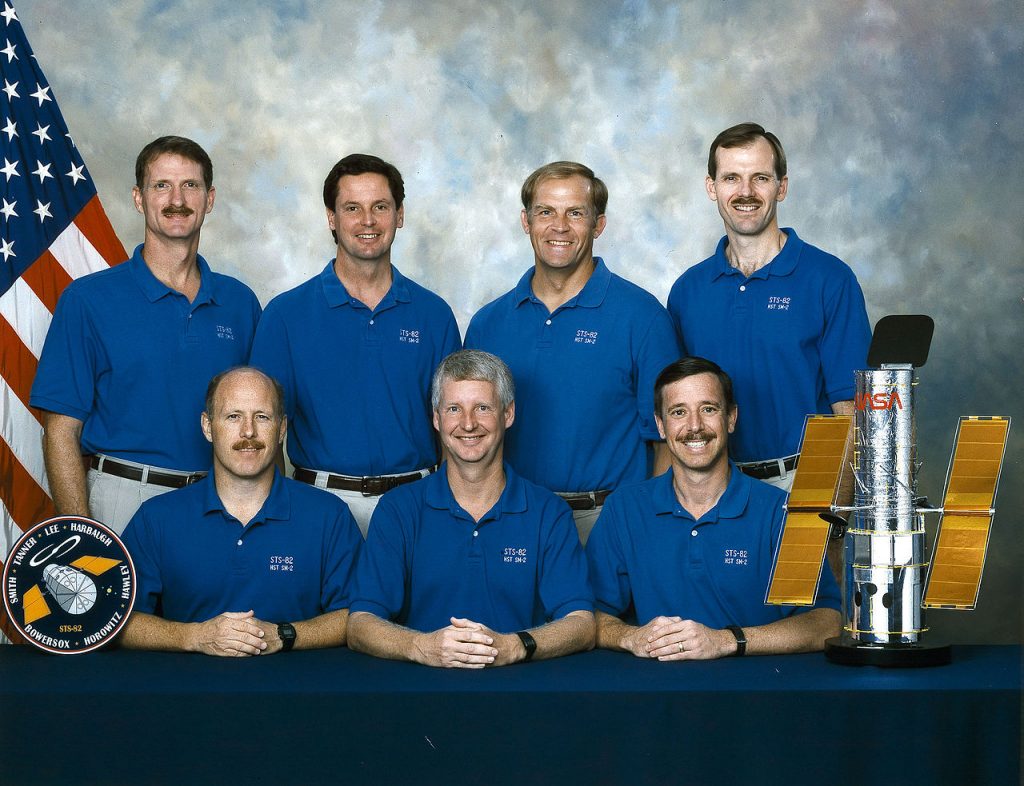
The crew assigned to the STS-82 mission included (seated front left to right) Kenneth D. Bowersox, commander; Steven A. Hawley, mission specialist; and Scott J. Horowitz, pilot. On the back row (left to right) are Joseph R. Tanner, mission specialist; Gregory J. Harbaugh, mission specialist; Mark C. Lee, payload commander; and Steven L. Smith, mission specialist.
STS-113
STS-113 was a Space Shuttle mission to the International Space Station (ISS) flown by Space Shuttle Endeavour. During the 14-day mission in late 2002, Endeavour and its crew extended the ISS backbone with the P1 truss and exchanged the Expedition 5 and Expedition 6 crews aboard the station. The Expedition 6 Crew consisted of Donald Pettit (US), Ken Bowersox (US) and Nikolai Budarin (RU).
The Endeavour docked with the station on 25 November 2002 to begin seven days of station assembly, spacewalks and crew and equipment transfers. This was Endeavour’s last flight before entering its Orbiter Major Modification period and also the last shuttle mission before the Columbia disaster.(up)
Expedition 6
Expedition-6, Nov. 23, 2002 to May 3, 2003, was the sixth expedition to the International Space Station and the last three-man crew to reside on the station until the arrival of STS-121. During 5-1/2 months aboard the International Space Station, the crew worked with numerous U.S. and Russian science experiments. Bowersox and ISS Science Officer Don Pettit performed 2 EVAs (spacewalks)to continue the external outfitting of the orbital outpost. The Expedition-6 crew launched on STS-113 Space Shuttle Endeavour and returned to Earth on Soyuz TMA-1.The crew performed two spacewalks in support of maintenance and assembly of the International Space Station.
The mission was planned to be a four-month mission that was to end in March 2003 when Atlantis STS-114 was to fly to the Station with the Expedition 7 crew. The Columbia disaster, which occurred during the mission on 1 February, 2003 and resulted in the indefinite suspension of Shuttle flights, led to a change of plan such that the crew stayed on the station until May 2003. They returned to Earth on Soyuz TMA-1, and a reduced Expedition 7 crew with just two members was delivered to the ISS on Soyuz TMA-2. The Space Shuttle was expected to be grounded for up to two years. Ongoing logistical support for the ISS would have to be carried out by Soyuz and Progress flights until the Space Shuttle returned to flight. The sixth crew of the International Space Station returned to Earth just after 10 p.m. EDT on 3 May 2003, the first time U.S. astronauts landed in a Russian Soyuz spacecraft. The capsule touched down approximately 276 miles (444 km) from its planned landing zone.
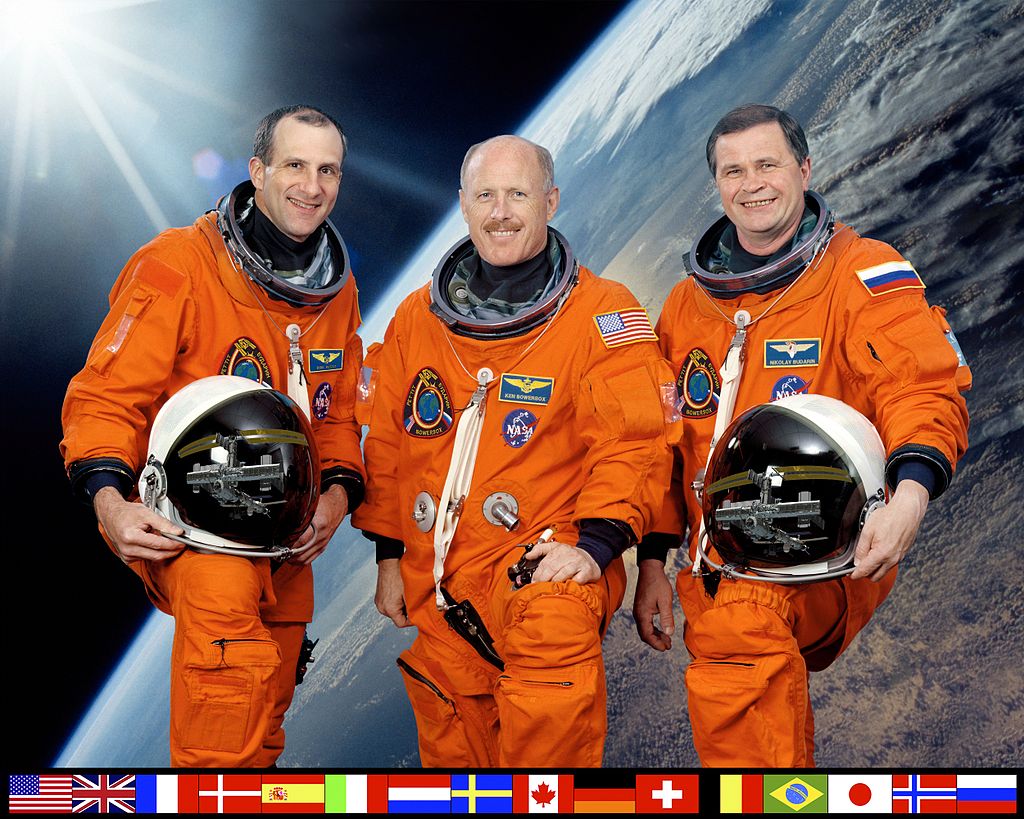
Donald Pettit (US), Ken Bowersox (US) and Nikolai Budarin (RU)
Soyuz TMA-1
Soyuz TMA-1, was a Soyuz mission to the International Space Station (ISS) launched by a Soyuz FG launch vehicle with a Russian-Belgian cosmonaut crew blasted off from the Baikonur Cosmodrome in Kazakhstan. This was the fifth Russian Soyuz spacecraft to fly to the International Space Station. It was also the first flight of the TMA-class Soyuz spacecraft. While the Soyuz TMA-1 was in orbit, the Columbia shuttle accident occurred and required a change in crew changeout process. The Soyuz system would become the sole method for crew to launch to and return from ISS, until the space shuttle was returned to service in July 2005.
Soyuz TMA-1 disembarked from ISS on May 4, 2003 and immediately began its return to Earth, marking the first entry and descent for this Soyuz class. A technical malfunction caused the Soyuz control system to abandon the gentler controlled entry and descent and instead fall back to the harsher ballistic reentry and descent. This resulted in a steep and off target landing of the spacecraft. The craft landed 300 miles short of the planned area, and the crew was subjected to severe gravitational loads. Communication with the Soyuz was lost because one antenna was ripped off during descent, and two more did not deploy. The crew regained communications through an emergency transmitter after landing. Due to this event, future crews would be provided with a satellite phone to establish contact with recovery forces.

